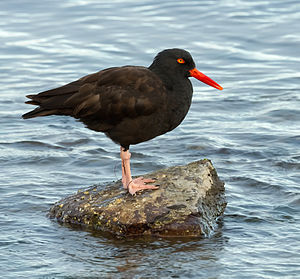Cliff Oystercatcher
| Cliff Oystercatcher | ||||||||
|---|---|---|---|---|---|---|---|---|

Cliff Oystercatcher ( Haematopus bachmani ) |
||||||||
| Systematics | ||||||||
|
||||||||
| Scientific name | ||||||||
| Haematopus bachmani | ||||||||
| Audubon , 1838 |
The cliff oystercatcher ( Haematopus bachmani ) is a species from the oystercatcher family (Haematopodidae). The scientific species name goes back to John Bachman , a friend of the first descriptor.
description
The cliff oystercatcher is a large, black colored wader. He reaches a body length of about 44 centimeters. The wingspan is 80 centimeters. The red beak becomes around 9 centimeters long. The legs are pink. The iris is bright yellow and surrounded by a red eye ring. The plumage color varies from region to region. The further north you go, the darker the color.
nutrition
The cliff oystercatcher feeds mainly on invertebrates, mussels, sea slugs and crustaceans, which they look for in the intertidal zone. It uses its powerful beak to get the prey out of its shell.
distribution and habitat
The cliff oystercatcher inhabits the North American coastal areas from the Aleutian Islands in the north to Baja California in the south. Its distribution area overlaps with that of the brown-mantled oyster fisherman . He never goes far from the coast. Stony, cliff-rich coasts with quiet bays are preferred.
Reproduction
The cliff oystercatcher is territorial during the breeding season. The bowl-like nests are built near the coast. The nest is laid out with small stones and with mussel shells. The clutch consists of 2 to 3 eggs. The eggs even survive underwater for a short time. The clutch is incubated for around 26 to 28 days. The young birds are able to leave the nest after only one day. The young birds fledge after 40 days, but usually stay in their parents' territory until the next breeding season.
Danger
Although the total population is estimated at only 9,000 to 11,000 animals, the species is listed on the IUCN Red List as "not endangered". The species is a characteristic species of the north Pacific coast and is considered by the US Fish & Wildlife Service as particularly worthy of protection.
supporting documents
literature
- B. Anders & G. Falxa, The Birds of North America
- Richart Chandler: Shorebirds of the Northern Hemisphere . Christopher Helm Publishing House, London 2009, ISBN 978-1-4081-0790-4
Single receipts
- ↑ Chandler, p. 55
